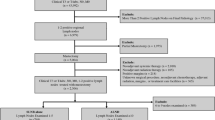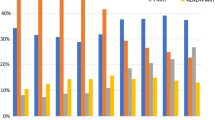Abstract
Purpose
Management of the axilla in patients with early-stage breast cancer (ESBC) has evolved. Recent trials support less extensive axillary surgery in patients undergoing mastectomy. We examine factors affecting regional lymph node (RLN) surgery and outcomes in patients with ESBC undergoing mastectomy.
Methods
Women with clinical T1/2 N0 M0 invasive BC who underwent mastectomy with 1–2 positive nodes were selected from the National Cancer Database (2004–2015). Axillary surgery was defined by number of RLNs examined: 1–5 sentinel LN dissection (SLND), and ≥ 10 axillary LND (ALND). Binary logistic regression and survival analyses were performed to assess the association between axillary surgery and clinical characteristics, and overall survival (OS), respectively.
Results
34,243 patients were included: 13,821 SLND (40%) and 20,422 ALND (60%). SLND significantly increased from 21% (2004) to 45% (2015) (p < .001). Independent factors associated with SLND were treatment year, non-Academic centers, geographic region, tumor histology, and postmastectomy radiotherapy (PMRT). Multivariable survival analysis showed that ALND was associated with better OS (HR 0.78, 95% CI 0.72–0.83, p < .001) relative to SLND; however, there was no difference in patients with LN micrometastases treated without RT (HR 0.87, 95% CI 0.73–1.05, p = .153) or patients receiving PMRT (HR 0.92, 95% CI 0.76–1.13, p = .433).
Conclusions
SLND has significantly increased in patients undergoing mastectomy with limited axillary disease and is influenced by patient, tumor, and treatment factors. Survival outcomes did not differ by axillary treatment for patients with LN micrometastases treated without RT or patients who received PMRT. SLND may be considered in select patients with ESBC and limited axillary disease undergoing mastectomy.



Similar content being viewed by others
References
Jatoi I, Benson JR, Toi M (2016) De-escalation of axillary surgery in early breast cancer. Lancet Oncol 17(10):e430–e41
Giuliano AE, Hunt KK, Ballman K, Beitsch P, Whitworth PW, Blumencranz P et al (2011) Sentinel lymph node dissection with and without axillary dissection in women with invasive breast cancer and sentinel node metastasis: a randomized clinical trial. JAMA 305(6):569–575
Yao K, Liederbach E, Pesce C, Wang C, Winchester DJ (2015) Impact of the American College of Surgeons Oncology Group Z0011 randomized trial on the number of axillary nodes removed for patients with early-stage breast cancer. J Am Coll Surg 221(1):71–81
Caudle AS, Hunt KK, Tucker SL, Hoffman K, Gainer SM, Lucci A et al (2012) American College of Surgeons Oncology Group (ACOSOG) Z0011: impact on surgeon practice patterns. Ann Surg Oncol 19(10):3144–3151
Galimberti V, Cole BF, Zurrida S, Viale G, Luini A, Veronesi P et al (2013) Axillary dissection versus no axillary dissection in patients with sentinel-node micrometastases (IBCSG 23-01): a phase 3 randomised controlled trial. Lancet Oncol 14(4):297–305
Donker M, van Tienhoven G, Straver ME, Meijnen P, van de Velde CJ, Mansel RE et al (2014) Radiotherapy or surgery of the axilla after a positive sentinel node in breast cancer (EORTC 10981-22023 AMAROS): a randomised, multicentre, open-label, phase 3 non-inferiority trial. Lancet Oncol 15(12):1303–1310
Bilimoria KY, Stewart AK, Winchester DP, Ko CY (2008) The National Cancer Data Base: a powerful initiative to improve cancer care in the United States. Ann Surg Oncol 15(3):683–690
Ong CT, Thomas SM, Blitzblau RC, Fayanju OM, Park TS, Plichta JK et al (2017) Patient age and tumor subtype predict the extent of Axillary Surgery among breast cancer patients eligible for the American College of Surgeons Oncology Group Trial Z0011. Ann Surg Oncol 24(12):3559–3566
NCDB PUF (2015) Data Dictionary. http://ncdbpuf.facs.org/node/259
United States Census Bureau GD. Census Regions and Divisions of the United States.https://www2.census.gov/geo/pdfs/maps-data/maps/reference/us_regdiv.pdf
Kaplan E, Meier P (1958) Nonparametric estimation from incomplete observations. J Am Stat Assoc 53:457–481
Breslow NE (1975) Analysis of survival data under the proportional hazards model. Int Stat Rev 43(1):45–57
Cox D (1972) Regression models and life tables. J R Stat Soc 34:187–220
Bergkvist L, de Boniface J, Jonsson PE, Ingvar C, Liljegren G, Frisell J et al (2008) Axillary recurrence rate after negative sentinel node biopsy in breast cancer: three-year follow-up of the Swedish Multicenter Cohort Study. Ann Surg 247(1):150–156
Giuliano AE, Ballman K, McCall L, Beitsch P, Whitworth PW, Blumencranz P et al (2016) Locoregional recurrence after sentinel lymph node dissection with or without axillary dissection in patients with sentinel lymph node metastases: long-term follow-up from the American College of Surgeons Oncology Group (Alliance) ACOSOG Z0011 Randomized Trial. Ann Surg 264(3):413–420
Giuliano AE, Haigh PI, Brennan MB, Hansen NM, Kelley MC, Ye W et al (2000) Prospective observational study of sentinel lymphadenectomy without further axillary dissection in patients with sentinel node-negative breast cancer. J Clin Oncol 18(13):2553–2559
Veronesi U, Paganelli G, Viale G, Luini A, Zurrida S, Galimberti V et al (2003) A randomized comparison of sentinel-node biopsy with routine axillary dissection in breast cancer. N Engl J Med 349(6):546–553
Krag DN, Anderson SJ, Julian TB, Brown AM, Harlow SP, Costantino JP et al (2010) Sentinel-lymph-node resection compared with conventional axillary-lymph-node dissection in clinically node-negative patients with breast cancer: overall survival findings from the NSABP B-32 randomised phase 3 trial. Lancet Oncol 11(10):927–933
Giuliano AE, Ballman KV, McCall L, Beitsch PD, Brennan MB, Kelemen PR et al (2017) Effect of axillary dissection versus no axillary dissection on 10-year overall survival among women with invasive breast cancer and sentinel node metastasis: the ACOSOG Z0011 (Alliance) Randomized Clinical Trial. JAMA 318(10):918–926
Robinson K, Pockaj BA, Wasif N, Kaufman K, Gray (2014) Richard. Have the American College of Surgeons Oncology Group Z0011 trial results inluenced the number of lymph nodes removed during sentinel lymph node dissection? Am J Surg 208(6):1060–1064
FitzSullivan E, Bassett RL, Kuerer HM, Mittendorf EA, Yi M, Hunt KK et al (2017) Outcomes of sentinel lymph node-positive breast cancer patients treated with mastectomy without axillary therapy. Ann Surg Oncol 24(3):652–659
Milgrom S, Cody H, Tan L, Morrow M, Pesce C, Setton J et al (2012) Characteristics and outcomes of sentinel node-positive breast cancer patients after total mastectomy without axillary-specific treatment. Ann Surg Oncol 19(12):3762–3770
Snow R, Reyna C, Johns C, Lee MC, Sun W, Fulp WJ et al (2015) Outcomes with and without axillary node dissection for node-positive lumpectomy and mastectomy patients. Am J Surg 210(4):685–693
Fisher B, Jeong JH, Anderson S, Bryant J, Fisher ER, Wolmark N (2002) Twenty-five-year follow-up of a randomized trial comparing radical mastectomy, total mastectomy, and total mastectomy followed by irradiation. N Engl J Med 347(8):567–575
Joyce DP, Manning A, Carter M, Hill AD, Kell MR, Barry M (2015) Meta-analysis to determine the clinical impact of axillary lymph node dissection in the treatment of invasive breast cancer. Breast Cancer Res Treat 153(2):235–240
Houvenaeghel G, Boher JM, Reyal F, Cohen M, Garbay JR, Classe JM et al (2016) Impact of completion axillary lymph node dissection in patients with breast cancer and isolated tumour cells or micrometastases in sentinel nodes. Eur J Cancer 67:106–118
Sanghani M, Balk EM, Cady B (2009) Impact of axillary lymph node dissection on breast cancer outcome in clinically node negative patients: a systematic review and meta-analysis. Cancer 115(8):1613–1620
de Boniface J, Frisell J, Andersson Y, Bergkvist L, Ahlgren J, Ryden L et al (2017) Survival and axillary recurrence following sentinel node-positive breast cancer without completion axillary lymph node dissection: the randomized controlled SENOMAC trial. BMC Cancer 17(1):379
van Roozendaal LM, de Wilt JH, van Dalen T, van der Hage JA, Strobbe LJ, Boersma LJ et al (2015) The value of completion axillary treatment in sentinel node positive breast cancer patients undergoing a mastectomy: a Dutch randomized controlled multicentre trial (BOOG 2013-07). BMC Cancer 15:610
Savolt A, Peley G, Polgar C, Udvarhelyi N, Rubovszky G, Kovacs E et al (2017) Eight-year follow up result of the OTOASOR trial: the Optimal treatment of the axilla—surgery or radiotherapy after positive sentinel lymph node biopsy in early-stage breast cancer: a randomized, single centre, phase III, non-inferiority trial. Eur J Surg Oncol 43(4):672–679
Sola M, Alberro JA, Fraile M, Santesteban P, Ramos M, Fabregas R et al (2013) Complete axillary lymph node dissection versus clinical follow-up in breast cancer patients with sentinel node micrometastasis: final results from the multicenter clinical trial AATRM 048/13/2000. Ann Surg Oncol 20(1):120–127
Galimberti V, Cole BF, viale G, veronesi P, Vicini E, Intra M et al (2017) Axillary dissection vs. no axillary dissection in patients with cT1-T2cN0M0 breast cancer and only micrometastases in the sentinel node(s): ten-year results of the IBCSG 23-01 Trial. San Antonio Breast Cancer Symposium
Ragaz J, Olivotto IA, Spinelli JJ, Phillips N, Jackson SM, Wilson KS et al (2005) Locoregional radiation therapy in patients with high-risk breast cancer receiving adjuvant chemotherapy: 20-year results of the British Columbia randomized trial. J Natl Cancer Inst 97(2):116–126
Overgaard M, Nielsen HM, Overgaard J (2007) Is the benefit of postmastectomy irradiation limited to patients with four or more positive nodes, as recommended in international consensus reports? A subgroup analysis of the DBCG 82 b&c randomized trials. Radiother Oncol. 82(3):247–253
Funding
There was no external funding for this work.
Author information
Authors and Affiliations
Contributions
OP and SK contributed for study conception and design; OP and SK analyzed the data. OP, KK, CA, and SK prepared the manuscript. DY, EA, and SK provided critical revisions to the manuscript. OP, KK, CA, DY, EA, and SK reviewed the manuscript.
Corresponding author
Ethics declarations
Conflict of interest
All the authors declare that they have no conflict of interest.
Informed consent
This study utilizes retrospective, de-identified information. Informed consent was not necessary.
Research involving human and animal participants
This article does not contain any studies with human participants or animals performed by any of the authors.
Rights and permissions
About this article
Cite this article
Picado, O., Khazeni, K., Allen, C. et al. Extent of regional lymph node surgery and impact on outcomes in patients with early-stage breast cancer and limited axillary disease undergoing mastectomy. Breast Cancer Res Treat 171, 461–469 (2018). https://doi.org/10.1007/s10549-018-4840-9
Received:
Accepted:
Published:
Issue Date:
DOI: https://doi.org/10.1007/s10549-018-4840-9




